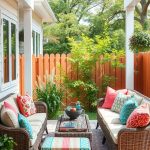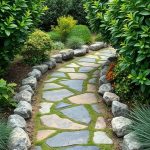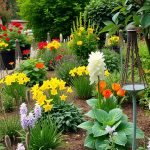Transforming your outdoor space doesn’t have to break the bank. With just a little creativity and some simple ideas, you can elevate your yard without spending a fortune. Here’s a collection of 29 inexpensive landscaping ideas to help you spruce up your garden while keeping your budget intact.
Upcycled Tire Planters

Upcycled tire planters are a fun and budget-friendly way to add color and life to your garden. Instead of tossing out old tires, why not transform them into unique plant pots? This idea not only brightens your outdoor space but also helps reduce waste.
In the image, you can see vibrant flowers blooming in various painted tires. Each planter features a burst of colors, showcasing cheerful blooms that catch the eye. The use of different colored tires adds a playful touch, making the garden feel lively and inviting.
Creating your tire planters is simple. Start by cleaning the tires to remove dirt and debris. Once they’re clean, you can paint them in your favorite colors to match your garden’s theme. After they dry, fill them with soil and your choice of flowers or plants. Not only do they provide a unique design element, but tire planters are also durable and weather-resistant.
Not just for flowers, you can use this method for herbs or even small vegetables. It’s a versatile option that brings charm and creativity to your landscaping without breaking the bank.
Repurposed Pallet Garden

Creating a repurposed pallet garden is a fun and budget-friendly way to add some greenery to your outdoor space. This approach not only recycles materials but also gives you a unique garden setup that can be tailored to your taste.
The image showcases a vibrant arrangement of flowers and herbs nestled within wooden pallets. The vertical design saves space and makes it easy to access plants for care or harvesting. Using pallets allows you to easily create different levels and sections, enhancing the visual appeal of your garden.
Consider planting a mix of colorful blooms like zinnias and daisies, along with fragrant herbs such as mint and thyme. These choices not only look good but also attract pollinators, adding life to your garden. You can even use the vertical slats of the pallet as a support for climbing plants or as a backdrop for trailing vines.
To get started, simply find some old pallets and make sure they’re safe for planting. You can clean them up and paint them for a pop of color. Fill the sections with soil and select your favorite plants. This is an engaging project that allows you to express your creativity while beautifying your yard.
DIY Gravel Pathway

Creating a DIY gravel pathway is a simple way to enhance your garden and improve accessibility. The image shows a lovely curved gravel path that invites you to explore the beautifully landscaped area. Lush flowers and greenery line the sides, adding color and life to the scene.
To start your gravel pathway, you’ll need some materials like gravel, landscape fabric, and edging stones. First, decide on the path’s layout. A gentle curve, like the one in the image, can make your garden feel more inviting.
Next, mark the path using stakes and string. Remove any grass or weeds where the path will go. Lay down landscape fabric to prevent weeds from growing through. Then, add a layer of gravel, leveling it out as you go. The gravel gives a rustic charm and is a budget-friendly option.
Finally, finish the edges with stones or bricks to keep the gravel contained and maintain a tidy appearance. The result is not only practical but also enhances the overall look of your garden, making it a welcoming space for you and your guests.
Vertical Garden on a Budget

Creating a vertical garden is a fun and budget-friendly way to bring life to your space. The image shows a beautifully arranged wall featuring various plants in pots, showcasing how simple it can be to start your own vertical garden.
Using wooden slats as a base, this setup allows you to maximize space while adding greenery to your home or patio. Hanging planters and potted plants of different sizes and shapes create visual interest. You can choose low-maintenance plants, like succulents or ferns, which are perfect for beginners.
To get started, all you need are some wooden boards, small pots, and your favorite plants. You can easily find affordable materials at local hardware stores or even repurpose old wood. Use sturdy hooks to secure the pots, ensuring they stay in place as your plants grow.
This vertical garden not only saves space but also adds a unique touch to your surroundings. It’s a great way to express your creativity while enjoying the benefits of gardening. Plus, you can easily change the plants seasonally or as your preferences evolve.
Budget-Friendly Herb Spiral

Creating a herb spiral is a fun and practical way to add greenery to your garden without breaking the bank. This design not only maximizes space but also provides a variety of herbs at your fingertips.
The image showcases a beautifully arranged herb spiral, stacked with various herbs like mint, thyme, and basil. Each layer offers different growing conditions, allowing herbs to thrive in their preferred environment.
Building your own herb spiral can be done with materials like stones, bricks, or even repurposed containers. Start by choosing a sunny spot in your yard and outline the spiral shape on the ground. As you stack the materials, leave space between the layers for planting.
This vertical garden design makes watering easier and ensures proper drainage, which is essential for healthy plants. Plus, it adds a unique visual element to your outdoor space.
Using a herb spiral not only saves money on herbs from the store but also encourages you to use fresh ingredients in your home cooking. Imagine snipping some fresh basil for your pasta or mint for a refreshing drink!
Stone Border for Flower Beds

Creating a stone border for your flower beds is a simple and cost-effective way to enhance your garden. The image showcases a vibrant flower bed surrounded by a charming stone border. The mix of colors from the flowers, including yellows, pinks, and reds, adds a lively touch.
Using stones to define the garden space not only helps keep the soil in place but also adds visual interest. You can choose various types of stones, like river rocks or concrete pavers, to match your style. The stones create a clean line that separates the flowers from the surrounding area, making the garden look well-kept.
To get started, simply outline the area of your flower bed with stones. Place them closely together for a unified look. You can even mix and match different shapes and sizes for a unique appearance. The best part is that this project can be done in a day, making it an easy weekend task.
Mulching for Moisture Retention

Mulching is a simple and effective way to keep your garden healthy and thriving. The image shows young plants surrounded by a layer of mulch, which helps to retain moisture in the soil. This is especially important in warm weather when plants can dry out quickly.
Using mulch not only conserves water but also helps to suppress weeds. When weeds are kept at bay, your plants can absorb more nutrients and water without competition. The mulch in the picture is made up of small pieces of organic material, which will break down over time, enriching the soil.
Another benefit is that mulch can regulate soil temperature. It keeps the soil cooler in the summer and warmer in the winter, creating a more stable environment for your plants. This is a great tip for keeping your garden productive throughout the seasons.
To apply mulch, start by spreading a 2-3 inch layer around your plants. Be careful not to pile it up against the stems, as this can cause rot. Mulching is an inexpensive landscaping idea that can make a significant difference in your garden’s health.
Creating a Colorful Flower Bed

When you think about landscaping, creating a lively flower bed is one of the easiest and most enjoyable projects. A colorful flower bed can brighten up any outdoor space and bring joy throughout the seasons.
Imagine vibrant reds, yellows, pinks, and whites all blending harmoniously. This image shows a beautiful arrangement of flowers that are not only visually appealing but also relatively easy to maintain. Selecting flowers like gerberas, daisies, and zinnias can add a cheerful touch to your garden.
To start your own flower bed, choose a sunny spot in your yard. Most flowers thrive with at least six hours of sunlight daily. Next, prepare the soil by loosening it and adding some compost to enrich it. Once that’s done, you can begin planting your flowers.
Consider mixing different heights and colors for a more dynamic look. Plant taller flowers in the back and shorter ones in the front. This arrangement creates depth and allows every flower to shine. Water your flowers regularly and remove any weeds that pop up to keep your flower bed looking fresh and lively.
As the seasons change, your flower bed will evolve too. Some flowers may bloom earlier than others, which can keep your garden looking vibrant for months. With just a bit of planning and care, you’ll create a welcoming space that invites everyone to enjoy the beauty of your flowers.
Decorative Homemade Bird Feeder

Creating a decorative homemade bird feeder is a fun and budget-friendly way to attract birds to your garden. The image captures a charming bird feeder that blends beautifully with its surroundings. It hangs from a branch, providing a perfect perch for feathered visitors.
The feeder’s design features a lovely roof and an open area for birds to easily access their food. You can fill it with seeds or nuts, inviting a variety of colorful birds to enjoy a meal. Not only does this add a touch of nature to your landscaping, but it also brings life to your outdoor space.
To make your own feeder, gather materials like wood or even repurposed materials. Cut the pieces to size and assemble them into a sturdy structure. Once it’s painted or decorated to your liking, hang it in a tree or near your garden flowers. The sight of birds fluttering around will surely bring a smile to your face.
This project is not just for birdwatching; it’s also a chance to teach kids about nature. Encourage them to help with the construction and filling of the feeder. Watching the birds come and go will spark curiosity and appreciation for wildlife.
Natural Stone Seating Area

A natural stone seating area is a charming addition to any outdoor space. In this image, you can see a circular arrangement of unique stone seats, inviting you to relax and enjoy the surroundings. The soft colors of the rocks blend beautifully with the greenery around them.
The layout is not only functional but also visually appealing. This design encourages conversations and gatherings, making it a perfect spot for family and friends. The stone pathway connecting the seating area adds a natural touch, ensuring it feels like a well-integrated part of the garden.
Incorporating plants around the seating enhances the cozy atmosphere. They provide a sense of privacy and connection to nature, making it an ideal escape from daily stress. This simple landscaping idea can transform a plain backyard into a peaceful retreat.
Building a stone seating area doesn’t have to break the bank. You can gather stones locally and arrange them creatively. By doing some of the work yourself, you can save money while adding a personal touch to your landscape.
Budget-Friendly Water Feature

A water feature can be a lovely addition to any garden, and you don’t need to spend a lot to create one. The image shows a charming small fountain surrounded by lush greenery and colorful flowers. This setup not only adds visual interest but also brings soothing sounds of water into your outdoor space.
The simple design of the fountain allows it to blend seamlessly with the garden. You can see how the circular stone base frames the fountain nicely, making it a focal point without being overwhelming. The plants around it, including vibrant flowers and leafy greens, enhance the natural beauty of the setup.
Creating your own budget-friendly water feature can be as easy as finding a suitable container, adding a small pump, and placing it in your garden. You can even use materials like old pots or stones to create a unique look. Don’t forget to arrange a few plants around it to tie everything together. This simple addition will elevate your garden’s charm without breaking the bank.
Creating a Rock Garden

Creating a rock garden is a fun and cost-effective way to enhance your outdoor space. In this design, rocks and stones play a major role, offering structure and a natural feel. The image shows a beautiful arrangement of succulents and smooth stones, showcasing how nature can be incorporated seamlessly.
When planning your rock garden, consider the types of plants that thrive in your area. Succulents, like those pictured, are fantastic choices due to their low maintenance needs. Their unique shapes and colors add interest without requiring too much effort.
Start by selecting a location that gets plenty of sunlight. Arrange your rocks in a way that mimics nature, placing larger stones as accents and smaller ones to fill gaps. Layering different sizes adds depth and visual appeal. Once your structure is in place, plant your chosen greenery around the rocks. Don’t forget to add some gravel or sand for better drainage.
This type of garden not only looks appealing but also supports local wildlife. Birds and beneficial insects will appreciate the shelter provided by the rocks and plants. Plus, a rock garden is a great conversation starter when you have friends over.
In conclusion, a rock garden is an inexpensive, stylish option for landscaping. With just a little creativity and effort, you can create a serene space that showcases the beauty of nature right in your backyard.
Planting Perennials for Longevity

When it comes to creating a vibrant garden, planting perennials is a smart and cost-effective choice. The image showcases a beautiful array of colorful flowers, highlighting how perennials can add life and color to any outdoor space.
Perennials come back year after year, making them a fantastic investment for your garden. This means less time and money spent on replanting each season. The flowers in the image, with their varied hues from bright pinks to sunny yellows, demonstrate the diverse options available to gardeners.
Incorporating perennials into your landscaping can also enhance biodiversity by attracting pollinators like bees and butterflies. These creatures play a crucial role in our ecosystem, and having a variety of flowers can encourage them to visit your garden regularly.
To get the most out of your perennial plants, it’s important to choose varieties that thrive in your local climate. When selecting plants, consider their size, color, and bloom time to create a layered and dynamic look.
Don’t forget about maintenance! While perennials are generally low-maintenance, regular watering and occasional deadheading can help keep them looking their best. Enjoy the beauty and longevity that perennials bring to your garden!
Edible Landscaping with Fruits and Vegetables

Transforming your garden into an edible landscape is a fun and rewarding way to enjoy the outdoors. Imagine walking through a lush garden filled with vibrant fruits and vegetables, just like in the image above. It’s a delightful sight, with colorful fruits hanging from trees and rows of leafy greens ready for harvest.
Incorporating edible plants not only beautifies your space but also provides fresh produce for your kitchen. You can plant fruit trees like apples or oranges alongside vegetables such as spinach and kale. This mix creates a diverse and appealing landscape.
To start your edible garden, choose a sunny spot and prepare the soil. You can plant fruit bushes at the end of your garden for a natural boundary. Place vegetables like tomatoes and peppers in the center, making them easy to access.
Don’t forget about the seasonal aspects. Planting different crops throughout the year ensures your garden is always full of life. You can enjoy a vibrant display of colors while also having fresh ingredients for your meals.
Edible landscaping is not just practical; it also invites pollinators. Bees and butterflies will love visiting your garden, adding an extra layer of beauty. By blending aesthetics with functionality, you create a space that is both enjoyable and productive.
Low-Cost Garden Lighting Ideas

Adding garden lighting can completely transform your outdoor space, especially at night. In this image, we see a charming pathway lined with soft, inviting light. The lights are placed strategically along the sides, guiding you along the path while highlighting the lush greenery surrounding it.
For a budget-friendly approach, consider solar-powered lights. They don’t require wiring and charge during the day, providing free energy to illuminate your garden at night. You can find these in various styles, from modern to rustic, allowing you to choose lights that match your garden’s vibe.
Another simple idea is to use string lights. Drape them around trees or along fences for a cozy atmosphere. You can even wrap them around the railing of your porch for added charm. String lights are often inexpensive and can be a fun DIY project.
Lastly, don’t overlook the power of lanterns. Placing a few lanterns along your walkway or around seating areas creates a warm glow. You can opt for battery-operated versions to avoid any wiring hassles. These low-cost options can greatly enhance the beauty of your garden while keeping your budget in check.




